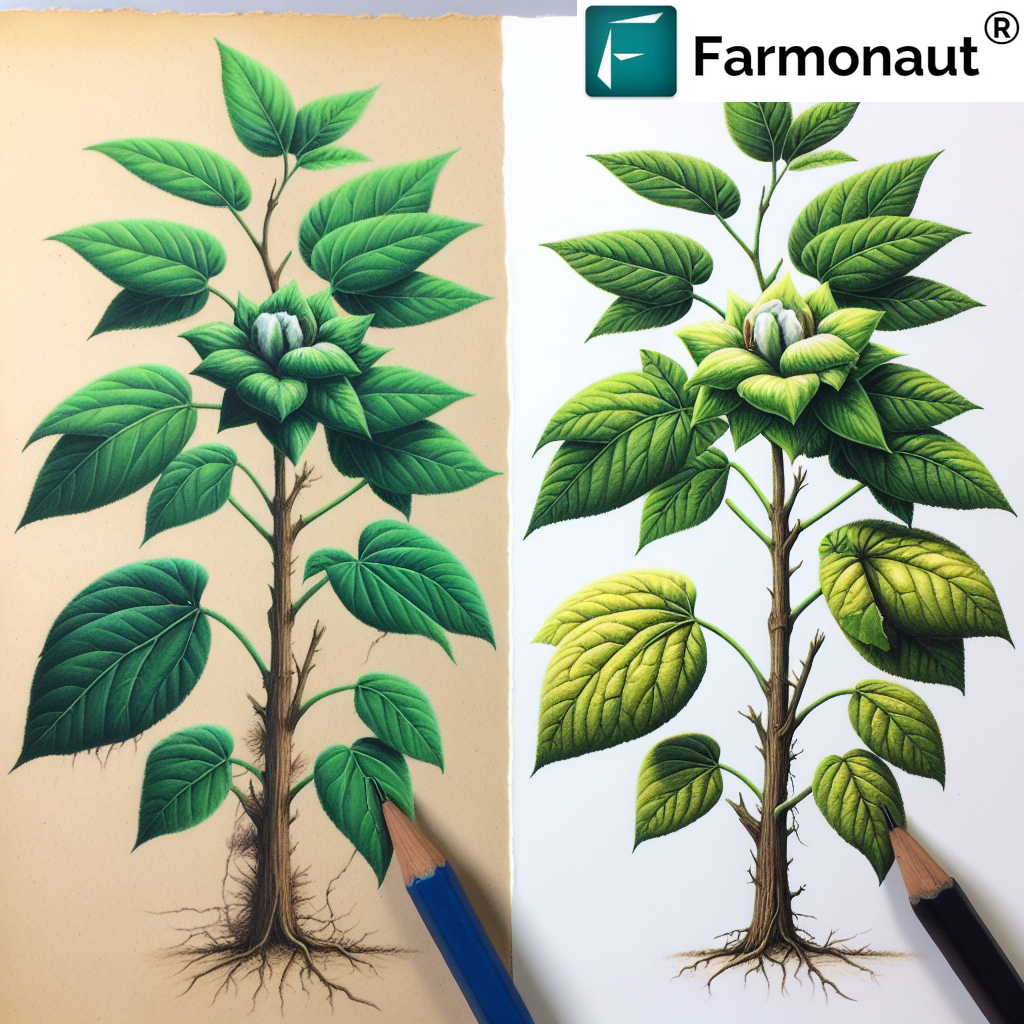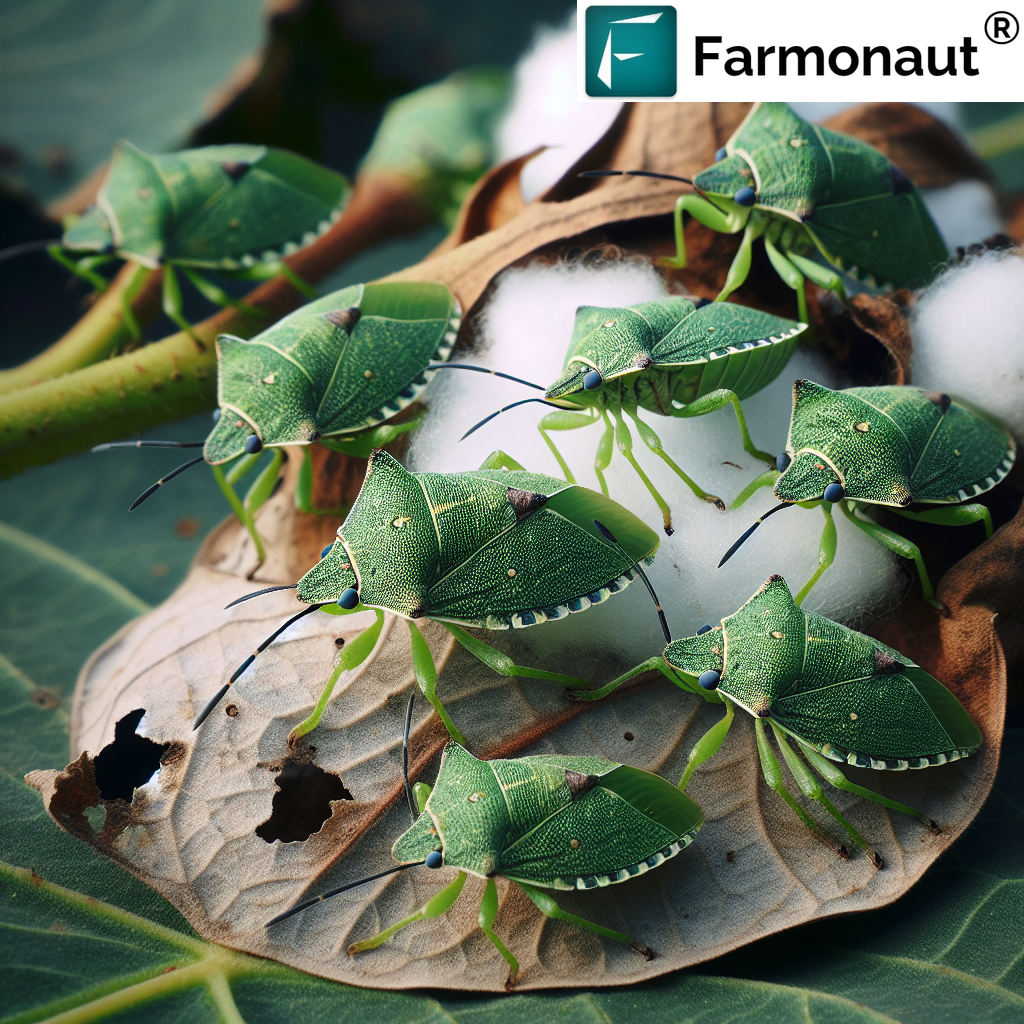Cotton Jassids: Effective Management and Resistance Strategies for Healthy Cotton Crops

As agricultural technology experts at Farmonaut, we understand the critical importance of managing pests and diseases in cotton cultivation. One of the most persistent and damaging pests that cotton farmers face is the cotton jassid. In this comprehensive guide, we’ll explore the world of cotton jassids, their impact on cotton crops, and the most effective strategies for management and resistance. We’ll also discuss how our advanced satellite-based farm management solutions can help farmers combat these pests more efficiently.
Understanding Cotton Jassids
Cotton jassids, scientifically known as Amrasca biguttula biguttula, are small, wedge-shaped insects that pose a significant threat to cotton crops worldwide. These tiny pests, often referred to as leafhoppers, can cause extensive damage to cotton plants, leading to substantial yield losses if not managed properly.
Characteristics of Cotton Jassids
- Size: Adults are approximately 2-3 mm long
- Color: Pale green to yellowish-green
- Wings: Transparent, held roof-like over the body
- Movement: Quick, sideways movement when disturbed
Life Cycle of Cotton Jassids
Understanding the life cycle of cotton jassids is crucial for implementing effective control measures. The life cycle typically consists of three stages:
- Egg stage: Females lay eggs inside the leaf tissue or veins of cotton plants.
- Nymph stage: Nymphs undergo five instars before reaching adulthood.
- Adult stage: Adults can live for 15-20 days and are capable of producing multiple generations in a single growing season.
The Impact of Jassids on Cotton
Jassids in cotton can cause significant damage to the crop, leading to substantial economic losses for farmers. The severity of the damage depends on various factors, including the pest population density, plant growth stage, and environmental conditions.
Symptoms of Jassid Infestation
- Leaf curling and yellowing
- Stunted plant growth
- Reduced photosynthesis
- Premature leaf shedding
- Reduced boll formation and fiber quality
At Farmonaut, our satellite-based crop health monitoring system can detect early signs of jassid infestation by analyzing vegetation health indices. This early detection allows farmers to take timely action and prevent widespread damage.
Management Strategies for Cotton Jassids
Effective management of cotton jassids requires an integrated approach that combines various control methods. Here are some strategies that we recommend to our farmers:
1. Cultural Control
- Early sowing to avoid peak jassid populations
- Proper spacing between plants to reduce pest pressure
- Removal and destruction of alternate host plants
- Balanced fertilizer application to promote plant vigor
2. Biological Control
Encouraging natural predators and parasitoids can help keep jassid populations in check. Some effective biological control agents include:
- Ladybird beetles
- Green lacewings
- Parasitic wasps
3. Chemical Control
While chemical control should be used judiciously, it can be effective in managing severe jassid infestations. Some recommended insecticides include:
- Imidacloprid
- Thiamethoxam
- Acetamiprid
Note: Always follow local regulations and guidelines when using chemical pesticides. Our Jeevn AI Advisory System can provide personalized recommendations on pesticide usage based on your specific crop conditions and local regulations.
4. Mechanical Control
- Use of yellow sticky traps to monitor and reduce adult jassid populations
- Regular weeding to eliminate alternative hosts
Resistance to Jassids in Cotton
Developing cotton varieties with resistance to jassids is a crucial long-term strategy for managing this pest. Resistance to jassids in cotton can be achieved through various mechanisms:
Types of Resistance
- Antibiosis: The plant negatively affects the biology of the pest, reducing its survival and reproduction.
- Antixenosis: The plant is less preferred by the pest for feeding or oviposition.
- Tolerance: The plant can withstand pest attack without significant yield loss.
Resistance Mechanisms in Cotton
Several plant characteristics contribute to resistance against jassids in cotton:
- Leaf hairiness: Hairy leaves can deter jassids from feeding and laying eggs.
- Leaf thickness: Thicker leaves are more difficult for jassids to penetrate.
- Biochemical factors: Presence of certain compounds that repel or deter jassids.
- Genetic resistance: Breeding programs have developed cotton varieties with inherent resistance to jassids.
Breeding for Jassid Resistance
At Farmonaut, we collaborate with agricultural research institutions to support the development of jassid-resistant cotton varieties. Our satellite-based monitoring system can assist in field trials by providing accurate data on plant health and pest pressure across large areas.
Integrating Technology in Jassid Management
Modern agricultural technologies play a crucial role in effective pest management. At Farmonaut, we offer several innovative solutions to help farmers combat cotton jassids more efficiently:
1. Satellite-Based Crop Health Monitoring
Our advanced satellite imagery analysis can detect early signs of jassid infestation by identifying changes in vegetation health indices. This allows farmers to take prompt action before the pest population reaches damaging levels.
To learn more about our satellite-based crop monitoring system, visit Farmonaut App.
2. AI-Powered Advisory System
Our Jeevn AI Advisory System analyzes real-time data from satellite imagery, weather forecasts, and historical pest patterns to provide personalized recommendations for jassid management. This includes optimal timing for pesticide application, suggestions for cultural control methods, and alerts for potential pest outbreaks.
3. Weather API for Pest Forecasting
Accurate weather data is crucial for predicting pest population dynamics. Our Weather API provides precise local weather information that can be integrated into pest forecasting models. Developers can access this API at Farmonaut Weather API Documentation.
4. Mobile Apps for On-the-Go Monitoring
Our mobile apps allow farmers to access real-time crop health data and pest management recommendations directly from their smartphones. Download our app for:
Comparative Analysis: Farmonaut vs. Traditional Monitoring Methods
Here’s a comparison of how Farmonaut’s satellite-based system compares to traditional drone and IoT-based farm monitoring methods:
| Feature | Farmonaut Satellite System | Drone-based Monitoring | IoT-based Monitoring |
|---|---|---|---|
| Coverage Area | Large scale (Thousands of hectares) | Medium scale (Hundreds of hectares) | Small scale (Tens of hectares) |
| Frequency of Data Collection | Daily to weekly | On-demand (weather dependent) | Continuous |
| Initial Setup Cost | Low | High | Medium to High |
| Operational Cost | Low | Medium | Low to Medium |
| Skill Level Required | Low (User-friendly interface) | High (Requires trained operators) | Medium (Requires technical setup) |
| Data Analysis | Advanced AI-powered analytics | Manual or semi-automated | Automated with limited scope |
| Weather Dependency | Low (Can penetrate clouds) | High (Clear weather needed) | Low |
| Scalability | Highly scalable | Limited scalability | Moderately scalable |
Case Studies: Successful Jassid Management with Farmonaut
While we don’t include specific case studies in this blog, it’s worth noting that numerous cotton farmers across various regions have successfully used Farmonaut’s technology to manage jassid infestations effectively. Our satellite-based monitoring and AI-powered advisory system have helped farmers reduce pesticide usage, improve crop yields, and increase overall profitability.
Future Perspectives in Jassid Management
As we look to the future, several promising developments are on the horizon for managing cotton jassids:
- Gene editing: CRISPR technology may allow for more precise development of jassid-resistant cotton varieties.
- Nanotechnology: Nanoparticle-based pesticides could provide more targeted and environmentally friendly control options.
- Advanced AI models: Improved machine learning algorithms will enhance the accuracy of pest prediction and management recommendations.
- Integration of multi-source data: Combining satellite imagery with ground-based sensors and historical data will provide even more comprehensive pest management solutions.
At Farmonaut, we are committed to staying at the forefront of these technological advancements to continue providing cutting-edge solutions for cotton farmers.
FAQ Section
Q1: How can I tell if my cotton crop is infested with jassids?
A1: Look for symptoms such as curling and yellowing of leaves, stunted plant growth, and the presence of small, green, wedge-shaped insects on the undersides of leaves. Our satellite-based monitoring system can also detect early signs of infestation through changes in vegetation health indices.
Q2: Are there any natural predators of cotton jassids?
A2: Yes, several natural predators can help control jassid populations, including ladybird beetles, green lacewings, and certain species of parasitic wasps.
Q3: How often should I monitor my cotton crop for jassids?
A3: Regular monitoring is crucial, especially during the vegetative and early reproductive stages of the cotton plant. With Farmonaut’s satellite monitoring system, you can receive daily to weekly updates on your crop’s health status.
Q4: Can resistant cotton varieties completely eliminate the need for other control measures?
A4: While resistant varieties significantly reduce jassid damage, they should be used as part of an integrated pest management approach. Other control measures may still be necessary, especially during severe infestations.
Q5: How can Farmonaut’s technology help me manage cotton jassids more effectively?
A5: Our satellite-based monitoring system can detect early signs of infestation, while our AI-powered advisory system provides personalized recommendations for pest management. This integrated approach helps you take timely and targeted action against jassids.
Conclusion
Effective management of cotton jassids requires a multi-faceted approach that combines traditional agricultural practices with modern technology. At Farmonaut, we are dedicated to providing farmers with the tools and knowledge they need to combat this persistent pest effectively. By leveraging our satellite-based monitoring system, AI-powered advisory services, and continuous research into pest management strategies, we aim to help cotton farmers worldwide achieve healthier crops and higher yields.
To experience the benefits of our advanced agricultural technology solutions, subscribe to Farmonaut today:
Together, we can revolutionize cotton farming and ensure a more sustainable and productive future for agriculture.














